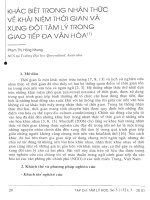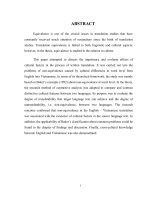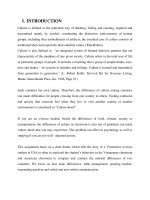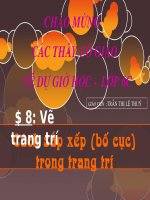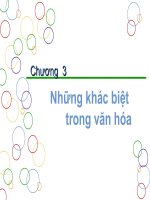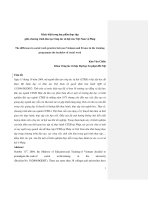Khác biệt trong văn hoá lớp học giữa Việt Nam và Mỹ (eng ver)
Bạn đang xem bản rút gọn của tài liệu. Xem và tải ngay bản đầy đủ của tài liệu tại đây (333.88 KB, 8 trang )
I. INTRODUCTION
Culture is defined as the patterned way of thinking, feeling and reacting, required and
transmitted mainly by symbol, constituting the distinctive achievements of human
groups, including their embodiments of artifacts; the essential core of culture consists of
traditional ideas and especially their attached values ( Kluckhohm).
Culture is also defined as "an integrated system of learned behavior patterns that are
characteristic of the members of any given society. Culture refers to the total way of life
of particular groups of people. It includes everything that a group of people thinks, says,
does and makes its systems of attitudes and feelings. Culture is learned and transmitted
from generation to generation." (L. Robert Kohls. Survival Kit for Overseas Living,
Maine: Intercultural Press, Inc. 1996, Page 23.)
Each countries has own culture. Therefore, the differences of culture among countries
can made difficulties for people crossing from one country to others. Feeling confusion
and anxiety that someone feel when they live or visit another country or another
environment is considered as “Culture shock”
If you are an oversea student, beside the differences of food, climate, society or
transportation, the differences of culture in classroom is also one of problems can made
culture shock that you may experience. This problem can affect to psychology as well as
studying if you are not well –adjusted person.
This assignment bases on a short drama which tells the story of a Vietnamese oversea
student in USA in other to analyzed the student’s behaviors in the Vietnamese classroom
and American classroom to compare and contrast the cultural differences of two
countries. We focus on four main differences: table arrangement, greeting teacher,
responding question and verbal and non-verbal communication.
II. THE SCENARIO
The main character of the story is Mo. She learned very hard for her dream – getting a
scholarship abroad. When the dream came true, Mo was really happy. However, after the
first day at The American School, she recognized that everything was not as easy as she
thought.
Scene 1: M stood in front of the classroom. She looked around the whole class, breathed
deeply and entered the classroom. M walked slowly to found her seat. She sat down next
a boy and observed the class. There was no one care of her appearance.
Scene 2: When the teacher came in the classroom, M stood up suddenly under surprising
eyes of her classmates and her teacher. She did know the reason why people stare at her
like that. She recognized quickly that she was the only one stood up for greeting. “What’s
happen? – The teacher asked. With a great embarrass, M said “No” and sat down.
Scene 3: The teacher lectured passionately. Sometime, she sat on the table. Mo really
shocked. It is an unacceptable action in her country. After the lecture, the teacher had a
question for all students. Many students raised their hand as freely as possible except Mo
– she put the elbow at the table. It was not a problem unless M did not stand up to answer
the question. Other students paid their attention to the strange girl with surprising eyes.
Moreover, Mo’s answering was so lengthy that the teacher had to interrupt. Beside, that
she used less eye-contact made the teacher seems to be not satisfied
The class time was end up. Mo felt shocked, disappointed and alone.
III. ANALYSIS
1. Table Arrangement
Table arrangement in American classroom is very difference from in Vietnamese
classroom.
In American classroom, there are many ways to arrange the classroom’s layout such as
U- Shape, circle, horseshoe, etc. It depends on the requirement of the subjects: students
have to work independently or work in pair, work in group. Teacher’s desk is often put
near student’s tables to reduce the distance between teacher and student. In addition,
American students can be free to choose and change their seat without permission of the
teacher.
Figure 1 American classroom layout is arranged U-shape
Most of Vietnamese classrooms layout are arranged traditionally. All tables are separated
into two or three columns. Students must follow the teacher’s arrangement and sit
following straight lines, face to the blackboard. Teacher’s desk is put on the platform and
separate from others. Teacher usually does not encourage student’s movement. This
layout is suitable for traditional teaching method but unsuitable for discussion,
cooperative learning and sharing material.
These differences of arrangement layout in Viet Nam and America are derived from the
difference of teaching method. American education encourage students learn by
themselves. Teacher just plays instructor’s role. In Vietnam, most of teachers apply
traditional method in which teacher is primary speaker and student is primary listener.
This difference of table arrangement between two countries can makes many new oversea
students feel puzzle at the first time they enter the classroom. The main character in our
story –Mo is an example. She had a little bit difficult to find a seat in the classroom as
well facing to other students in U-shape layout made her uncomfortable.
Figure 2 Vietnamese classroom‘s layout
2. Greeting teacher
Greeting teacher is one of the notable differences between Vietnamese classroom
and American classroom.
In Vietnam, when the teacher comes in or leave out the class, all students must stand up
solemnly to greet. This way of greeting is like the strict military discipline. Even though
teachers are young, they enjoy the great respect and prestige in Vietnamese society.
The student - teacher relationship likes the son – father relationship: son's respect for
his father's wisdom and of father's concern for his son's welfare. In contract, American
students keep their seat when their teacher comes in or leaves out the class. This
difference is caused by the different hofstede’s taxonomy of two countries. Viet Nam is
high distance country; therefore teachers are the people who have high position in
society. American is low distance country – teachers have no high position. However,
that is not mean American students do not respect their teachers but they express their
closer relationship. Moreover, they have a lot of ways to show their respect such as
completing assignment on time, join the lesson enthusiast,etc.
4. Respond to the question.
Vietnamese student and American student have some differences in responding the
question.
The first is raising hand.
Both of Vietnamese culture and American culture had to raise hand to answer the
question or ask the teacher’s permission. However, the way of raising hand between
Vietnamese student and American student is different. In Vietnam, student put their
elbow on the table in seriously posture while American student raise their hand as
comfortable as possible.
The second is the responding method.
It is common that Vietnamese student must stand up to give their answer while American
student can keep their seat and answer as freely as possible. The respect that students
show to the teachers is also evident in linguistic behavior. The terms of address that
students use in speaking to their teachers are the same as those they use in speaking to
their parents.In addition, Vietnamese student often ask their teacher’s permission by
saying “Em thưa cô!”.
“thưa cô cho em xin ra ngoài ạ”
“Em thưa cô, những nguyên nhân của ô nhiễm môi trường là……”
It shows the strong discipline and formality in the Vietnamese classroom.
These differences are caused by the distance society. Vietnamese society is power
distance society while American is non – distance society. Moreover, America is
democracy country. Therefore, student and teacher have equal position.
The third is expressing the answer.
Expressing the answer between Vietnamese and American is also different. American
student always expresses their answer concisely while Vietnamese student’s answer is
often lengthy. This is not only a characteristic of Vietnamese but also one of Asian in
general.
5. Verbal and non-verbal communication
In this picture, American student stared at Mo when she stood up because they were
shocked. They didn’t understand the reason why she stood up. Their look showed the
surprise at Mo’s motion. When someone is surprised, the eyebrows raise, the upper
eyelids raise to enlarge our eye openings, and the jaw drops. This is normal when
someone do strange thing, this is natural reaction of human, especially, through the look.
However, something on the face also contributes on the way of reaction. For example,
eyebrow cans creat the strong feeling when it combine with eye. In this situation, the eyes
as well as eyebrow of American student glower widely or some others stitch summarily
which show that they are surprise.
The second picture, Mo stands up to show her respect to teacher as a greeting. But,
she quickly realizes that she has made a mistake. Mo
understood that she had done a strange action which unlike everyone. In this situation,
Mo was very embarrassed, she raised her hand and touch her hair, one typical gesture
when someone is ashamed.
Clearly, Mo has done a series of strange things that it is difficult to understand for
everyone in class and it creates cultural shock not only to Mo but also to American
student.
Vietnamese’s answer
American’s answer
IV. CONCLUSION
Our assignment focused on four aspects: seating arrangement, greeting teacher,
responding to the question and verbal and non verbal communication base on the story of
Mo- an American oversea student.
Generally, Vietnam and America are countries have noticeable cultural differences.
In Vietnamese culture, respect is as the principle of all relationship. Their respect is
conveyed through language and demeanor. For their teacher, they show the respect by
avoiding direct eye-contact, standing up to greeting teacher or respond to the question or
dressing formal clothing to go to school. In contract, American student expresses their
respect through their action. They finish the assignment on time, join the lesson with feel
highly enthusiastically. This assignment indicated that culture shocks occurred with many
Vietnamese oversea students when they begin to study America.

